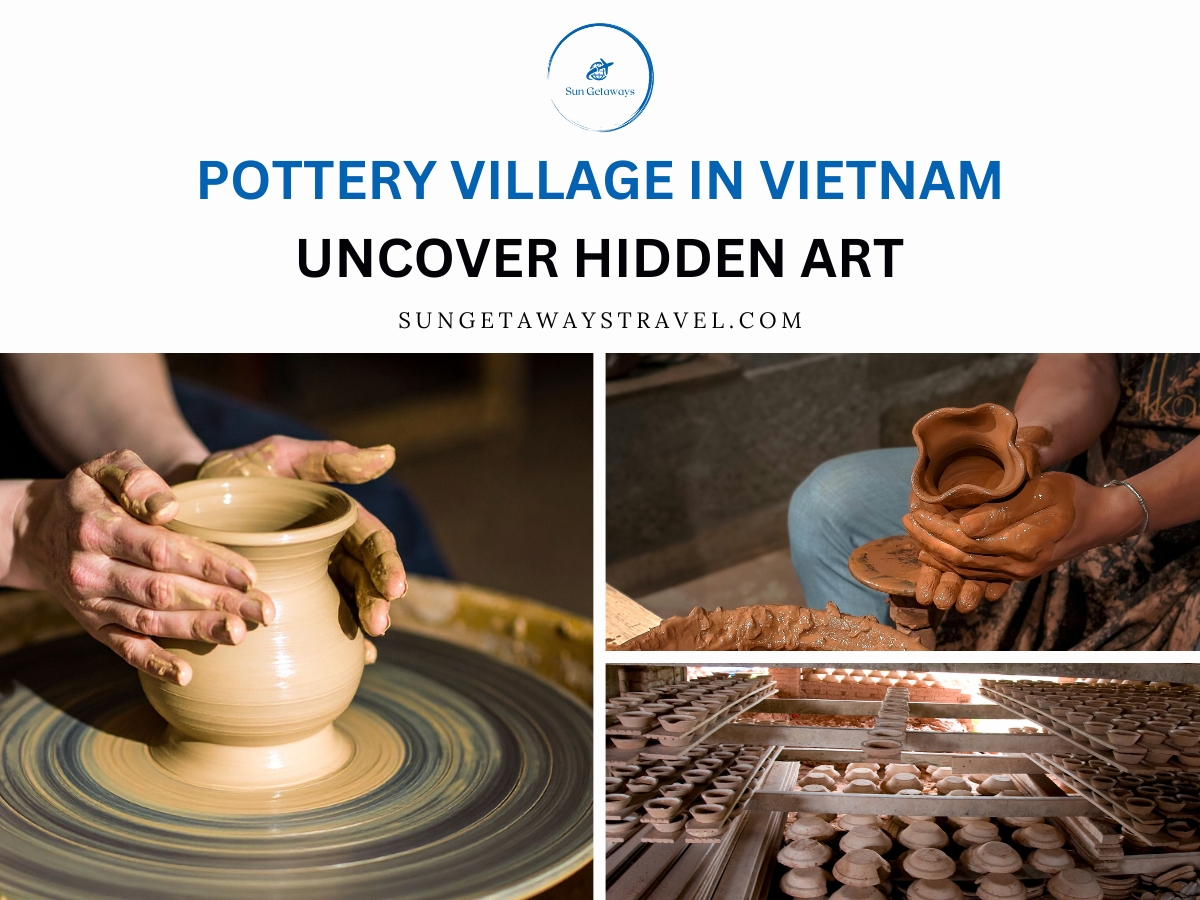Pottery Village in Vietnam – Uncover Hidden Art
 PhamDuong
PhamDuong Looking to combine culture, craftsmanship, and travel in a single unforgettable experience? Discover the charm of a pottery village in Vietnam, highlighted by the famous Bat Trang pottery village. Whether arriving from Europe, North America, or Australia, this guide takes you through history, hands-on workshops, local traditions, and practical tips to make your visit a standout moment on your Vietnam itinerary.
Key Takeaways
- Bat Trang pottery village is Vietnam’s most famous pottery destination, offering workshops, markets, and hands-on experiences.
- Travelers can visit other villages like Lai Thieu, Phu Lang, Tho Ha, Chu Dau, and Thanh Ha for diverse regional pottery styles.
- Popular souvenirs include teapots, cups, vases, figurines, and wall art, perfect for gifts or personal keepsakes.
- Participating in workshops lets you create your own pottery and understand the traditional craft firsthand.
1. The Artistic Heart of Pottery Village in Vietnam


Pottery village in Vietnam are living museums where clay transforms into functional and decorative art. Generations of artisans have perfected glazing, molding, and firing techniques, preserving traditions that date back centuries. Therefore, these villages often revolve around family-run workshops, where knowledge passes from one generation to the next.
The essence of a pottery village in Vietnam lies in its integration with local life. Streets bustle with artisans shaping clay on wheels, shops displaying vibrant ceramics, and children learning the craft from parents. This combination of living culture and craftsmanship creates a unique atmosphere for visitors.
Many villages, including Bat Trang pottery village, are located near rivers. Historically, the Red River provided both clay and transport for trade, shaping the development of these artisanal hubs. Today, tourists can explore kilns, join workshops, and witness ceremonies that honor the craft’s heritage.
Visitors to pottery village in Vietnam will quickly realize that these destinations offer more than art, they provide a tangible connection to Vietnamese history, community, and creativity.
2. Crafting Traditions and Timeless Techniques
2.1. Clay Preparation
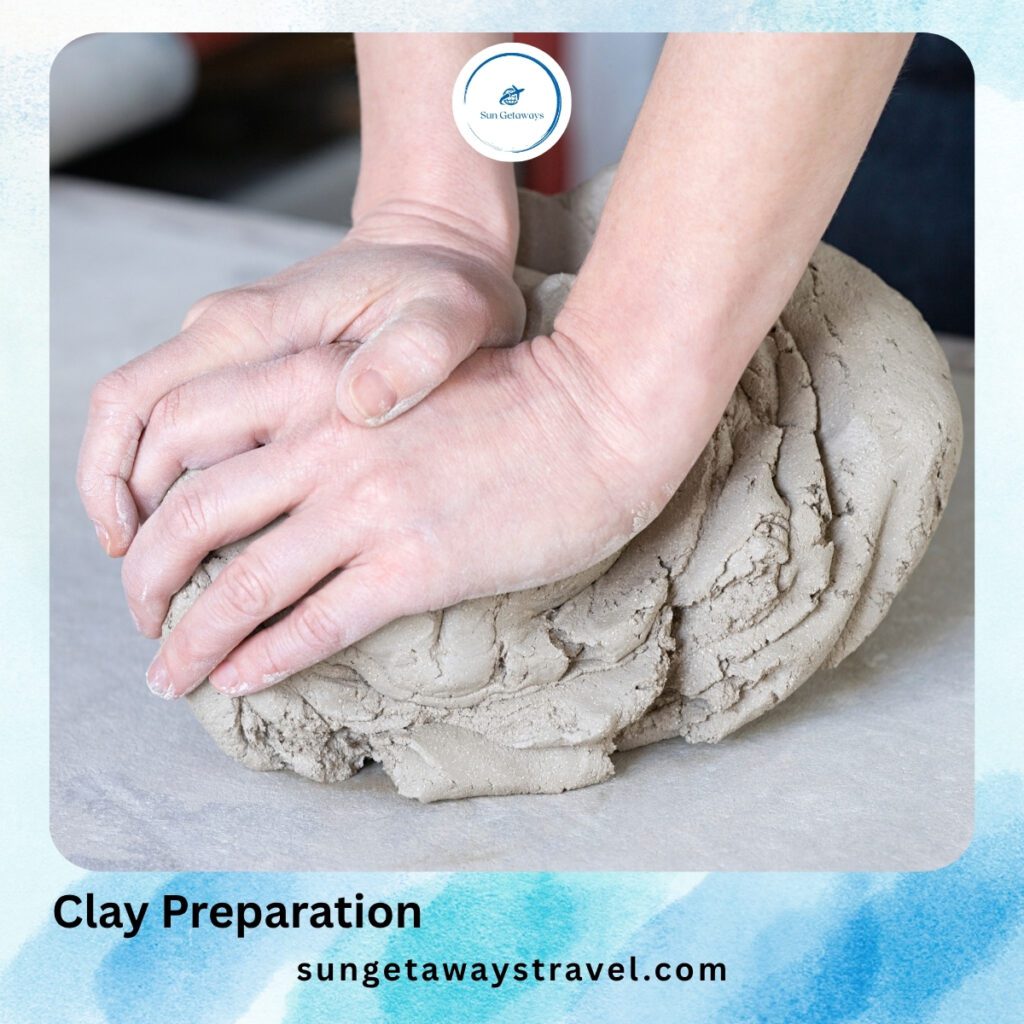

The journey of a pottery piece begins with selecting high-quality clay, often sourced locally. Because rtisans knead and refine the clay to remove impurities, ensuring durability and smooth texture. This stage requires skill, as even minor inconsistencies can affect the final product’s quality.
2.2. Molding and Shaping
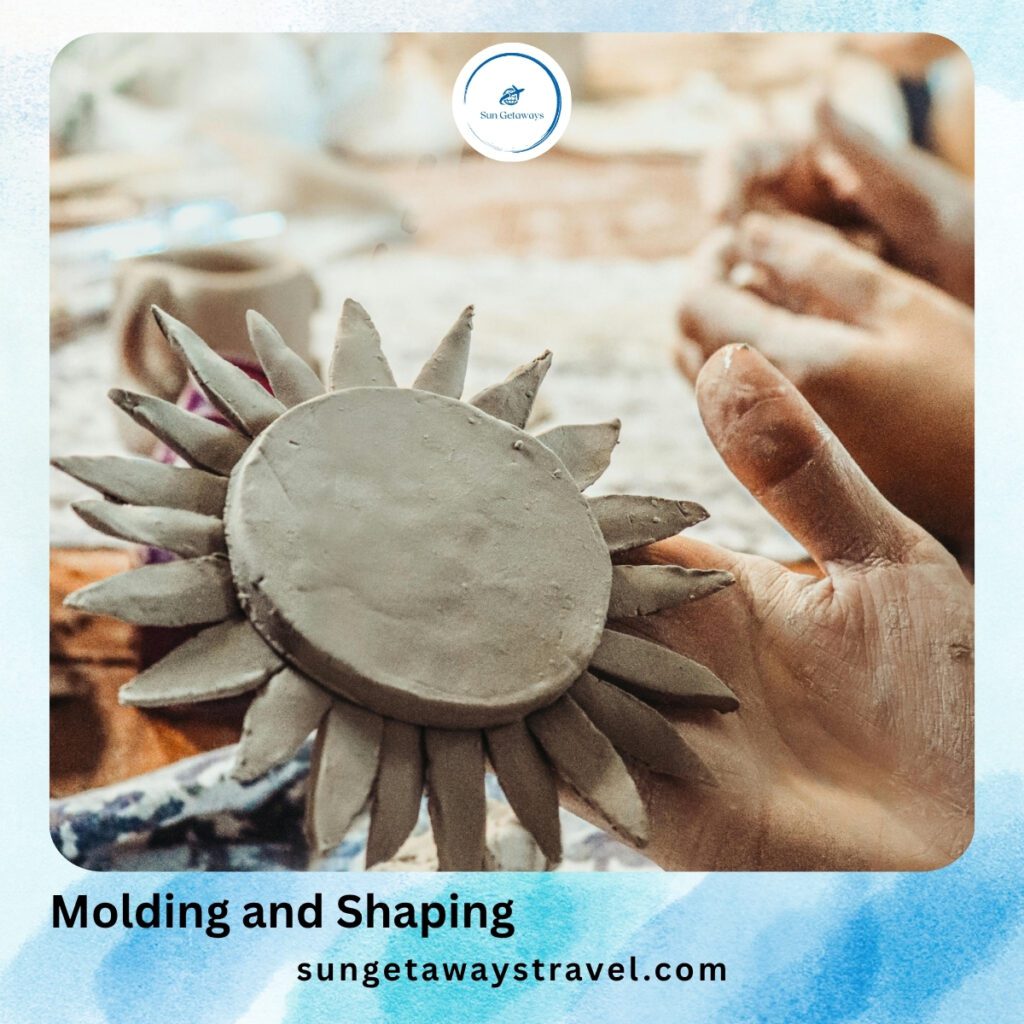

Traditional methods involve hand-shaping or wheel-throwing the clay. So visitors can join workshops near Hanoi’s Old Quarter, trying wheel-throwing under expert guidance. This lets travelers combine hands-on craft with a stroll through the city’s historic streets afterward.
2.3. Glazing Techniques
Vietnamese pottery is known for its colorful and intricate glazes. Because artisans apply multiple layers, sometimes incorporating mineral pigments to achieve distinct hues. Glazing not only enhances aesthetic appeal but also protects ceramics from water and heat damage.
2.4. Kiln Firing


The firing process is critical. Traditional wood-fired kilns create unique textures and subtle color variations. Many workshops close to Hoan Kiem Lake showcase these kilns, allowing tourists to witness authentic techniques while staying conveniently near central Hanoi attractions.
2.5. Decorative Techniques


Many pottery village in Vietnam also specialize in hand-painted motifs, relief patterns, and stamped designs. These embellishments reflect local folklore, religious symbolism, and regional aesthetics. Each piece becomes a story, bridging the past and present.
Moreover, y participating in workshops or guided demonstrations, visitors gain a better understanding of the craftsmanship and dedication involved.
3. Top 10 Pottery Villages in Vietnam
3.1. Bat Trang Pottery Village – Hanoi


Bat Trang pottery village is Vietnam’s most iconic ceramic hub, famous for teapots, vases, and decorative art pieces. So, visitors can participate in hands-on workshops guided by skilled artisans, shaping, glazing, and sometimes firing their own creations.
Therefore, many local schools bring children here to create personalized pottery, offering a fun and educational experience that nurtures creativity. Besides, families and tourists alike enjoy exploring the vibrant markets, watching traditional kilns, and learning about centuries-old techniques. Its close proximity to Hanoi makes it a convenient day trip for immersing in authentic craft culture.
3.2. Lai Thieu Pottery Village
Lai Thieu is celebrated for household ceramics and industrial-style pottery. Small workshops welcome visitors to observe artisans shaping clay and firing pieces. Therefore, ravelers gain insight into how traditional craft adapts to modern production methods, blending hands-on learning with cultural exploration.
3.3. Phu Lang Pottery Village


Phu Lang, a pottery village in Vietnam is known for rustic clay works fired in traditional kilns. So tourists can witness the entire process from clay preparation to finished pottery. Additionally, ts quiet streets and small workshops create an intimate, authentic cultural experience, allowing travelers to connect with centuries-old techniques.
3.4. Tho Ha Pottery Village
Famous for decorative ceramics with intricate relief patterns, Tho Ha offers workshops where visitors can try hand-painting techniques themselves. Moreover, located in Bac Ninh province, the village preserves centuries-old craftsmanship. The charming streets and artisan interactions highlight Vietnam’s rich cultural heritage.
3.5. Chu Dau Pottery Village
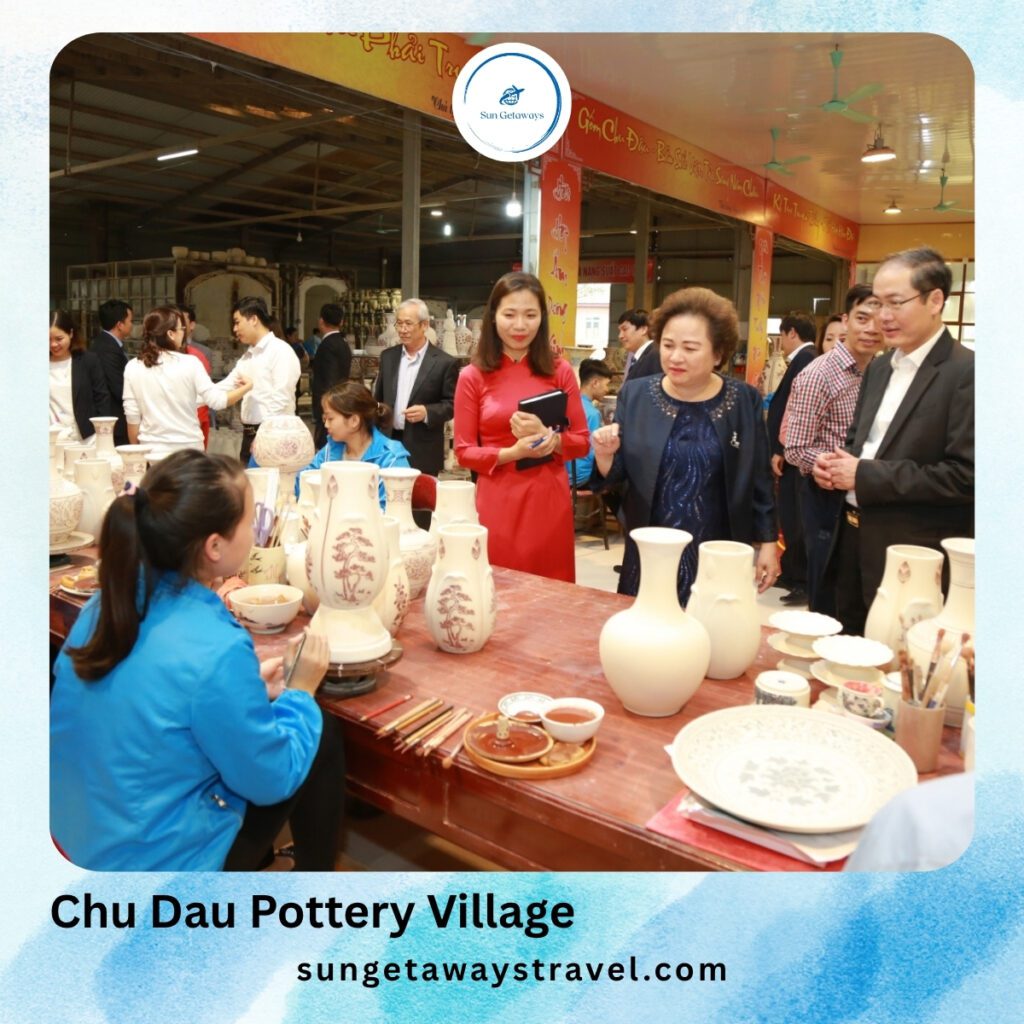

Chu Dau is renowned for blue-and-white ceramics and museum exhibitions. So, travelers can explore workshops producing both decorative and functional items. Additionally, the village’s historical significance gives insight into Vietnam’s evolving ceramic traditions over the centuries.
3.6. Cay Mai Pottery Village
Cay Mai, a small pottery village in Vietnam, is perfect for beginners. Because isitors can shape clay and observe family-run production techniques. Besides, situated within Ho Chi Minh City, it offers local insights into southern Vietnam’s pottery culture and a chance to interact directly with skilled artisans.
3.7. Bien Hoa Pottery Village


Bien Hoa is also a pottery village in Vietnam blends traditional craftsmanship with modern design. Therefore, tourists can watch artisans glaze and fire functional and decorative pieces. This village demonstrates how contemporary aesthetics integrate with time-honored pottery methods.
3.8. Vinh Long Pottery Village
Vinh Long specializes in eco-friendly pottery using river clay which is very well-known in the Mekong Delta region. Visitors can participate in workshops while enjoying scenic river surroundings. The village emphasizes sustainable practices alongside traditional techniques, creating a memorable cultural experience.
3.9. Phuoc Tich Pottery Village
Phuoc Tich, near Hue city in Thua Thien Hue province, is a historical village with centuries-old kiln traditions. Tourists can explore artisanal workshops and see hand-painted pottery. Its location adds a cultural dimension, connecting traditional craft with imperial heritage.
3.10. Thanh Ha Pottery Village
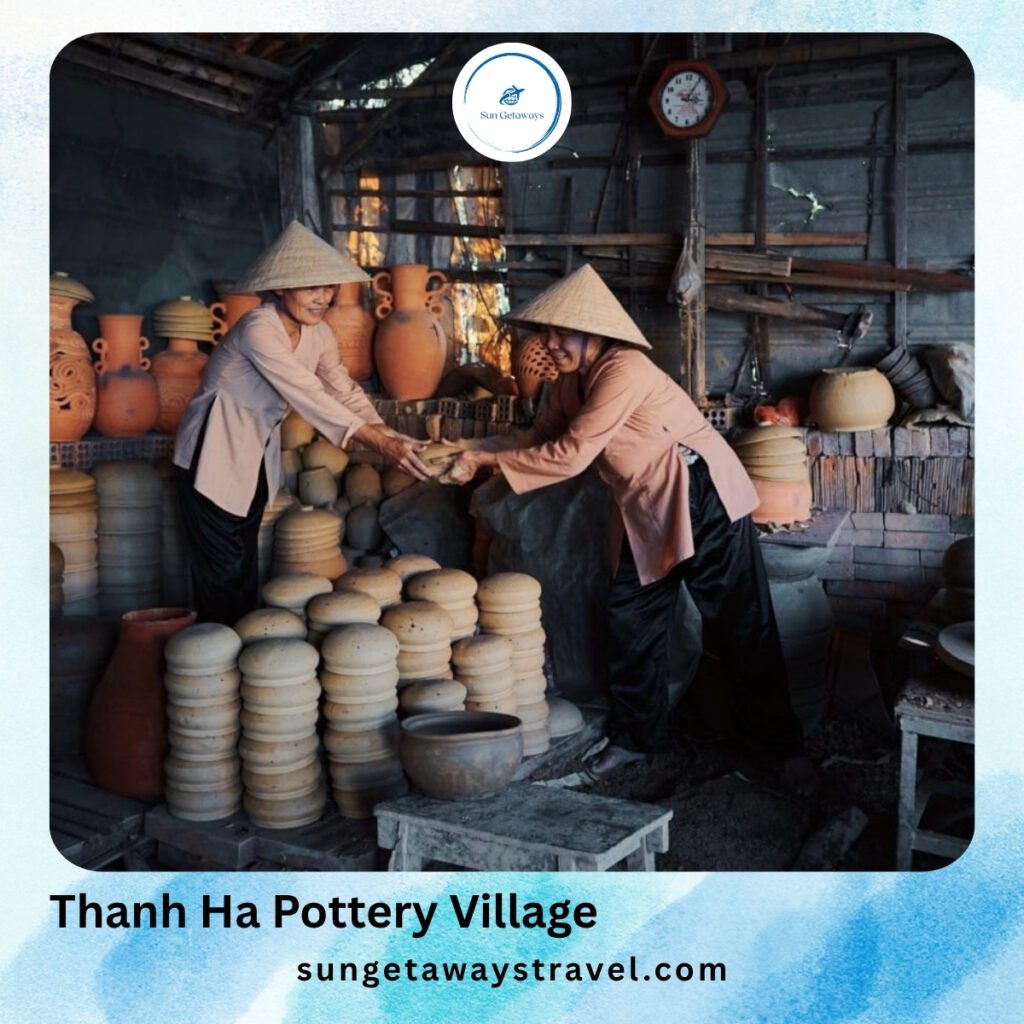

Thanh Ha which is located near Hoi An in Quang Nam province, promotes eco-conscious production and hands-on learning. When coming there, travelers can attend workshops, try clay shaping, and admire riverside kilns. Besides, ts proximity to Hoi An allows a seamless combination of pottery experience and heritage sightseeing.
4. Experience Pottery Like a Local
4.1. Participating in Workshops in Pottery Village in Vietnam


Workshops are the best way to experience a pottery village in Vietnam. Because you can shape, glaze, and sometimes fire your own creations. Besides, artisans guide visitors through each step, ensuring the process is educational and enjoyable. Many villages, including Bat Trang pottery village, offer packages that include materials, instruction, and finished pieces ready to take home.
4.2. Immersive Cultural Interaction
Spending time in these villages goes beyond making pottery. For example, engage with local families, learn about their daily routines, and hear stories passed through generations. Moreover, observing the rhythm of village life provides cultural context that enriches your travel experience.
5. Popular Pottery Products to Take Home
5.1. Traditional Teapots and Tableware


Visitors to Bat Trang pottery village often choose hand-painted teapots, cups, and decorative plates. Besides, each item reflects local artisan skills and traditional Vietnamese motifs. These pieces are perfect for daily use or as meaningful gifts, offering a tangible connection to your cultural journey.
Dive into a unique artistic adventure with our hands-on Bát Tràng ceramic and lacquer painting tour, ideal for those who love craft and tradition.
5.2. Decorative Figurines and Wall Art


Small figurines, incense holders, and ceramic wall art are popular souvenirs across pottery villages. Each product showcases unique designs, often unavailable outside the village. Therefore, tourists appreciate the artistic details, making these items memorable keepsakes that capture Vietnam’s rich heritage.
5.3. Creating and Packing Your Own Souvenir


Many workshops allow visitors to craft their own pottery item, providing a personalized experience. For fragile items, ask for protective wrapping to ensure safe transport home. In addition, ringing home handmade pottery lets you carry a piece of Vietnam’s cultural artistry with you.
Travelers can also consult through our quick support channel on WhatsApp for advice on selecting authentic products and planning visits.
6. Practical Travel Tips & Cultural Etiquette
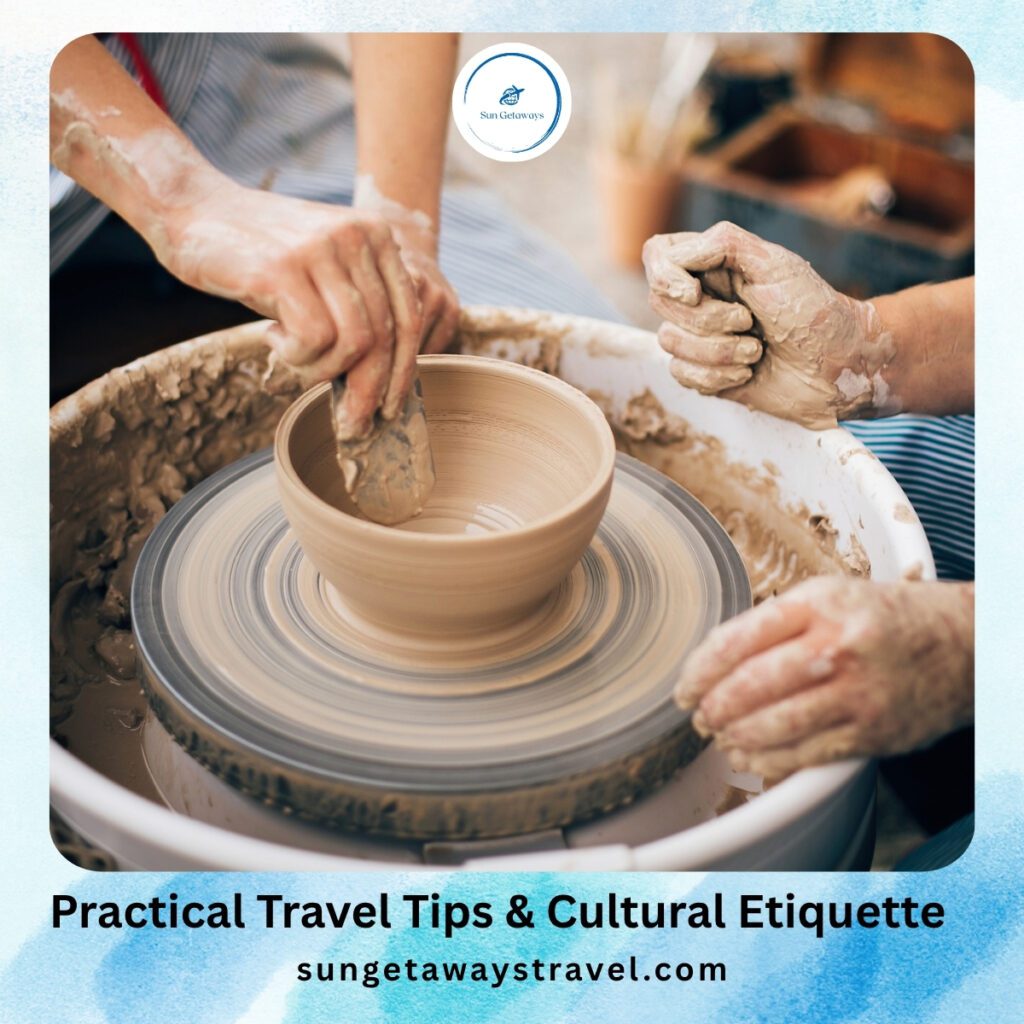

Following these tips ensures a meaningful, smooth, and enjoyable visit to pottery village in Vietnam.
- Timing Your Visit: Early morning or late afternoon is ideal to avoid crowds and heat.
- Booking Workshops: Reserve in advance, especially for international travelers.
- Transportation: Hire a local guide or taxi for convenient village access.
- Respect Artisan Spaces: Ask before photographing workshops or touching pieces.
- Purchasing Ceramics: Look for authenticity; support local craftspeople.
- Packing & Safety: Bring water, wear comfortable shoes, and protect fragile purchases during travel.
- Cultural Sensitivity: Be polite, listen to instructions, and appreciate local customs.
“A pottery village in Vietnam is not just a tourist stop, it’s a living cultural experience. Interacting with artisans provides insight into centuries of craft and connects travelers with the heart of Vietnamese culture.” – Ms. Emma Nguyen, Head of Tour Operations at Sun Getaways Travel
Conclusion
A journey through a pottery village in Vietnam, including the iconic Bat Trang pottery village, blends creativity, culture, and travel. From shaping clay to witnessing traditional kilns, each visit deepens your connection to local artisans and Vietnam’s heritage.
Design your own immersive craft-focused itinerary with Sun Getaways Travel. Explore hidden villages, join workshops, and create lasting memories. Start planning your personalized Vietnam adventure today and experience the country’s timeless pottery culture firsthand.
Ask a question
Leave a Comment (0)
No questions yet. Be the first to ask a question!









